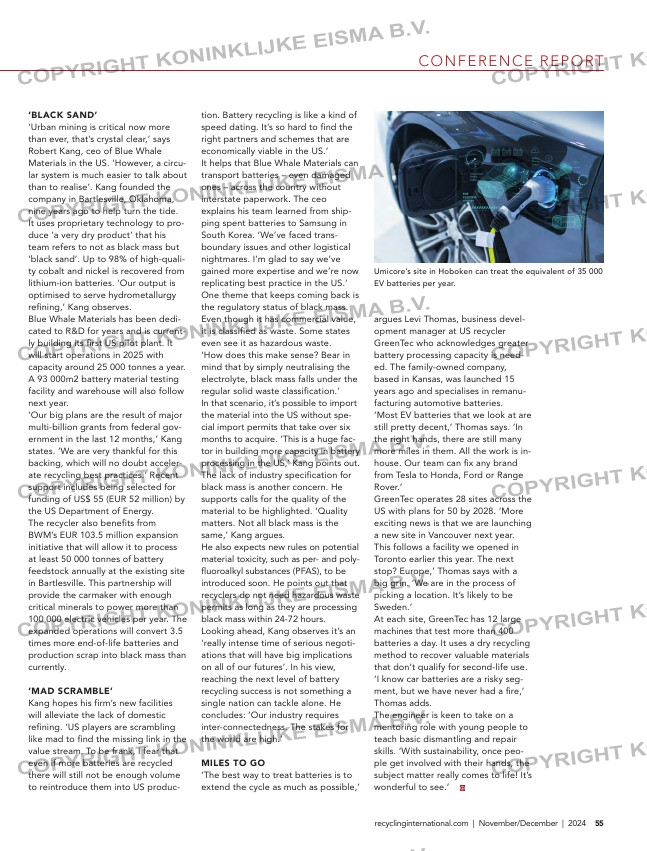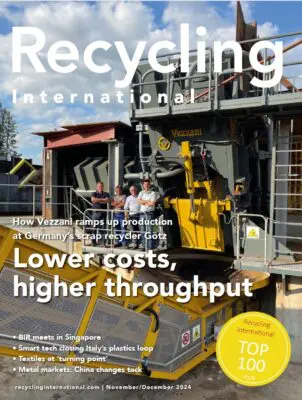Page 55 from: Recycling International November/December issue 2024

CONFERENCE REPORT
55recyclinginternational.com | November/December | 2024
‘Scrap usage will likely skyrocket by
the mid 2030s.’
Meanwhile, Japan is said to be invest-
ing almost EUR 2.3 billion in subsidies
to boost its domestic battery produc-
tion. Hubs will focus on salvaging pro-
duction scrap.
WHAT IT SAYS ON THE TIN?
Recyclers are working hard to reduce
contaminants from their dedicated
waste stream. ‘There is a lot of plastic
in the e-scrap and battery streams
these days,’ notes Keith Harrington,
global sales manager at Linev Systems
in the UK. ‘This makes sorting harder
than it has to be. Also, not a lot of bat-
tery material is magnetic. So magnetic
sorting is not the way to go and opti-
cal sorting is too superficial.’
While visiting a client in Italy to dem-
onstrate an X-ray sorter, Harrington
was initially greeted with some resis-
tance. ‘The recycler pulled out a bat-
tery he thought was wrongly sorted.
He showed me the label and made a
fuss. I offered to have it analysed at
the lab: it turned out to be an alkaline
battery all along. The label was
wrong.’
Harrington shakes his head in amuse-
ment. ‘It happens more often than
you’d think. I’ve encountered fake
nickel-cadmium batteries and all
sorts. Some labels are so old or dam-
aged you can hardly read them.
Either way, a battery is not always
what it says on the tin.’
According to Harrington, X-ray sort-
ing is the way to go and the BatteRay
six-channel automatic sorting line is
Linev’s answer. It can recognise up to
12 cells per second and realises a
purity of 99%. The system processes
around 0.5 tonnes per hour, providing
a detailed report of exactly what
materials and how much are in the
batch. ‘We can identify batteries
down to the granular level, any chem-
istry, no problem,’ Harrington says.
The artificial intelligence-driven solu-
tion was designed specifically to tack-
le small batteries. Large EV packs
cannot yet be identified. ‘We want to
target those pesky vape batteries. It
would go a long way to cleaning our
streets.’
‘BLACK SAND’
‘Urban mining is critical now more
than ever, that’s crystal clear,’ says
Robert Kang, ceo of Blue Whale
Materials in the US. ‘However, a circu-
lar system is much easier to talk about
than to realise’. Kang founded the
company in Bartlesville, Oklahoma,
nine years ago to help turn the tide.
It uses proprietary technology to pro-
duce ‘a very dry product’ that his
team refers to not as black mass but
‘black sand’. Up to 98% of high-quali-
ty cobalt and nickel is recovered from
lithium-ion batteries. ‘Our output is
optimised to serve hydrometallurgy
refining,’ Kang observes.
Blue Whale Materials has been dedi-
cated to R&D for years and is current-
ly building its first US pilot plant. It
will start operations in 2025 with
capacity around 25 000 tonnes a year.
A 93 000m2 battery material testing
facility and warehouse will also follow
next year.
‘Our big plans are the result of major
multi-billion grants from federal gov-
ernment in the last 12 months,’ Kang
states. ‘We are very thankful for this
backing, which will no doubt acceler-
ate recycling best practices.’ Recent
support includes being selected for
funding of US$ 55 (EUR 52 million) by
the US Department of Energy.
The recycler also benefits from
BWM’s EUR 103.5 million expansion
initiative that will allow it to process
at least 50 000 tonnes of battery
feedstock annually at the existing site
in Bartlesville. This partnership will
provide the carmaker with enough
critical minerals to power more than
100 000 electric vehicles per year. The
expanded operations will convert 3.5
times more end-of-life batteries and
production scrap into black mass than
currently.
‘MAD SCRAMBLE’
Kang hopes his firm’s new facilities
will alleviate the lack of domestic
refining. ‘US players are scrambling
like mad to find the missing link in the
value stream. To be frank, I fear that
even if more batteries are recycled
there will still not be enough volume
to reintroduce them into US produc-
tion. Battery recycling is like a kind of
speed dating. It’s so hard to find the
right partners and schemes that are
economically viable in the US.’
It helps that Blue Whale Materials can
transport batteries – even damaged
ones – across the country without
interstate paperwork. The ceo
explains his team learned from ship-
ping spent batteries to Samsung in
South Korea. ‘We’ve faced trans-
boundary issues and other logistical
nightmares. I’m glad to say we’ve
gained more expertise and we’re now
replicating best practice in the US.’
One theme that keeps coming back is
the regulatory status of black mass.
Even though it has commercial value,
it is classified as waste. Some states
even see it as hazardous waste.
‘How does this make sense? Bear in
mind that by simply neutralising the
electrolyte, black mass falls under the
regular solid waste classification.’
In that scenario, it’s possible to import
the material into the US without spe-
cial import permits that take over six
months to acquire. ‘This is a huge fac-
tor in building more capacity in battery
processing in the US,’ Kang points out.
The lack of industry specification for
black mass is another concern. He
supports calls for the quality of the
material to be highlighted. ‘Quality
matters. Not all black mass is the
same,’ Kang argues.
He also expects new rules on potential
material toxicity, such as per- and poly-
fluoroalkyl substances (PFAS), to be
introduced soon. He points out that
recyclers do not need hazardous waste
permits as long as they are processing
black mass within 24-72 hours.
Looking ahead, Kang observes it’s an
‘really intense time of serious negoti-
ations that will have big implications
on all of our futures’. In his view,
reaching the next level of battery
recycling success is not something a
single nation can tackle alone. He
concludes: ‘Our industry requires
inter-connectedness. The stakes for
the world are high.’
MILES TO GO
‘The best way to treat batteries is to
extend the cycle as much as possible,’
argues Levi Thomas, business devel-
opment manager at US recycler
GreenTec who acknowledges greater
battery processing capacity is need-
ed. The family-owned company,
based in Kansas, was launched 15
years ago and specialises in remanu-
facturing automotive batteries.
‘Most EV batteries that we look at are
still pretty decent,’ Thomas says. ‘In
the right hands, there are still many
more miles in them. All the work is in-
house. Our team can fix any brand
from Tesla to Honda, Ford or Range
Rover.’
GreenTec operates 28 sites across the
US with plans for 50 by 2028. ‘More
exciting news is that we are launching
a new site in Vancouver next year.
This follows a facility we opened in
Toronto earlier this year. The next
stop? Europe,’ Thomas says with a
big grin. ‘We are in the process of
picking a location. It’s likely to be
Sweden.’
At each site, GreenTec has 12 large
machines that test more than 400
batteries a day. It uses a dry recycling
method to recover valuable materials
that don’t qualify for second-life use.
‘I know car batteries are a risky seg-
ment, but we have never had a fire,’
Thomas adds.
The engineer is keen to take on a
mentoring role with young people to
teach basic dismantling and repair
skills. ‘With sustainability, once peo-
ple get involved with their hands, the
subject matter really comes to life! It’s
wonderful to see.’
Umicore’s site in Hoboken can treat the equivalent of 35 000
EV batteries per year.
52-53-54-55_batterycongress.indd 55 19-11-2024 13:18



